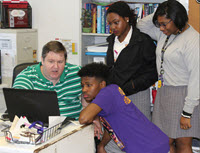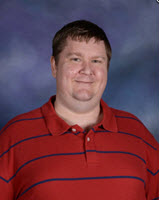
Researchers believe that large numbers of deep-diving marine mammals were living near the Deepwater Horizon site during the 2010 spill and may have experienced changes in their population distribution and abundance. Kendal Leftwich conducts acoustic research assessing how northern Gulf of Mexico dolphin populations changed and recovered over time to help researchers better understand the health of dolphin species living in affected areas.
Kendal also has been a bridge for a distinctive partnership with high school students, using his dolphin research as a platform to provide students with firsthand experiences conducting collaborative scientific research. During the 2015 – 2016 academic year, he taught the students how to analyze acoustic data for marine mammal sounds and compare the sounds to those described in scientific publications to determine their species.
Kendal is a Ph.D. student at the University of New Orleans Department of Physics and a GoMRI Scholar with the Littoral Acoustic Demonstration Center – Gulf Ecological Monitoring and Modeling (LADC-GEMM).

His Path
Kendal discovered his passion for physics while pursuing a degree in secondary mathematics education at the University of New Orleans (UNO). While taking an elective physics class, he realized his interest in math stemmed from the practical applications available through physics. As Kendal began teaching physics at Warren Easton Charter High School in New Orleans, Louisiana, he also began a master’s degree in physics at UNO where he met Professor Juliette Ioup.
Dr. Ioup uses ocean acoustics to study Gulf of Mexico dolphin populations with LADC-GEMM, a consortium that grew from the Littoral Acoustic Demonstration Center founded by the late Dr. George Ioup. Kendal became interested in analyzing underwater acoustical data for dolphin research through conversations with Dr. Juliette Ioup and began a physics Ph.D. program there. Later, Dr. Ioup offered him a graduate research position with LADC-GEMM.
His Work
Kendal uses signal processing techniques to observe dolphin populations since the Deepwater Horizon incident. Signal processing refers to the analysis or modification of a signal to gather new information from it, such as filtering an audio clip to hear faint or inaudible sounds more clearly. He processes acoustic data collected in 2015 using a LADC-GEMM-developed computer algorithm and statistical method to estimate the population densities of various dolphin species at certain northern Gulf of Mexico sites.
The algorithm analyzes the acoustic data and identifies marine mammal vocalizations or “clicks” that fall within the parameters Kendal provides. Because clicks that occur at a high frequency usually belong to dolphins, he uses the program to filter the data for all clicks above a certain frequency and to identify various types of dolphins. He then estimates the population density of dolphins in the area. Kendal plans to repeat this process with acoustic data collected in 2017 to track changes in the dolphins’ population over time.
His Learning
Working with Dr. Ioup, Kendal experienced scientific research first-hand and gained an understanding of the time, resources, and skills necessary for a successful project. He honed his signal processing skills through her mentorship, particularly in relation to Fourier transformation techniques and their applications. “Thanks to her guidance, my ability to perform research has grown from a task where I required a great deal of guidance to one I can lead and guide others to complete,” he said.

Kendal applied this personal growth to his mentorship of five Warren Easton Charter High School AP science students, who worked with him as research assistants during his data analysis. Students submitted weekly PowerPoint presentations documenting their analyses of the signals found, including the times and locations. His goal was to teach the students how to work independently using scholarly works to analyze and interpret data and to communicate and collaborate in a professional environment.
“I initially began working with the LADC-GEMM data hoping to gain experience, publish some research papers, and work with the physics and mathematics of signal processing,” said Kendal. “Over the last year, my motivations have grown with my experience and now include helping younger students learn how to conduct scientific research and work with a research group.”
Kendal presented his methods and experiences at the 2017 Gulf of Mexico Oil Spill and Ecosystem Science conference in a talk titled “Engaging High School Students in Studying Marine Mammals Observed near the BP Oil Spill.” He used this presentation as a proof of concept when approaching local school administrators about including more schools and students with the hands-on learning opportunity. “The program quickly developed into more than I expected, and the students learned a great deal about research, collaboration, work ethic, and being part of a university-level group,” he said. “Now, we are growing the program into a city-wide consortium of high school students working with LADC-GEMM data. We currently have four schools with approximately 40-50 students each who are working on various aspects of the data or in LADC-GEMM-related areas.”
His Future
Kendal wants to work as a university physics professor, where he can continue learning as a researcher and teach others through his courses. He suggests that students considering a scientific career should be determined and keep a positive attitude, which are keys to success in the face of obstacles. “One of the things that I like to tell my students on the first day of class is that my class is not about how smart you are – it is about how hard are you willing to work,” he said. “Scientific research is not easy and will have challenges and setbacks. The determining factor in your success is your ability to not get discouraged and continue working hard.”
Praise for Kendal
Dr. Ioup described Kendal as a diligent student who often asks thoughtful, difficult, and relevant questions. She praised Kendal’s sense of humor and his ability to connect with students at all levels. She has been impressed with both the research he is doing in her lab and his outreach work, “He is very much ahead of me in the outreach programs. I will make a suggestion only to find out he is already doing it. He works very hard all the time, including weekends, which is easy to understand with all that he is able to accomplish.”
The GoMRI community embraces bright and dedicated students like Kendal Leftwich and their important contributions. The GoMRI Scholars Program recognizes graduate students whose work focuses on GoMRI-funded projects and builds community for the next generation of ocean science professionals. Visit the LADC-GEMM website to learn more about their work.
************
The Gulf of Mexico Research Initiative (GoMRI) is a 10-year independent research program established to study the effect, and the potential associated impact, of hydrocarbon releases on the environment and public health, as well as to develop improved spill mitigation, oil detection, characterization and remediation technologies. An independent and academic 20-member Research Board makes the funding and research direction decisions to ensure the intellectual quality, effectiveness and academic independence of the GoMRI research. All research data, findings and publications will be made publicly available. The program was established through a $500 million financial commitment from BP. For more information, visit https://gulfresearchinitiative.org/.
© Copyright 2010-2018 Gulf of Mexico Research Initiative (GoMRI) – All Rights Reserved. Redistribution is encouraged with acknowledgement to the Gulf of Mexico Research Initiative (GoMRI). Please credit images and/or videos as done in each article. Questions? Contact web-content editor Nilde “Maggie” Dannreuther, Northern Gulf Institute, Mississippi State University (maggied@ngi.msstate.edu)
